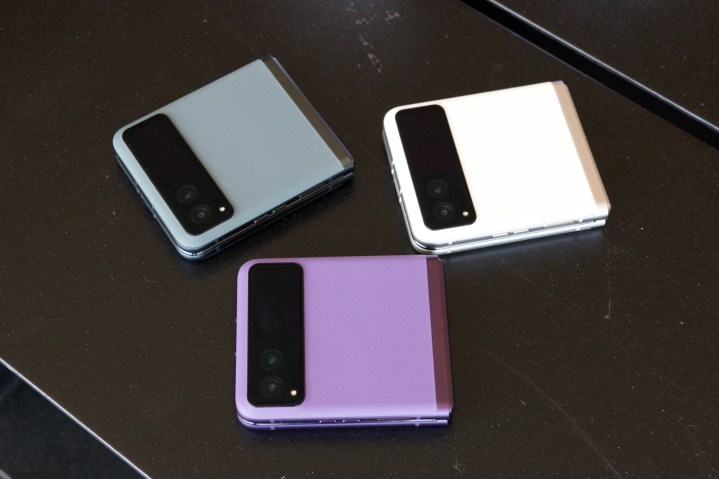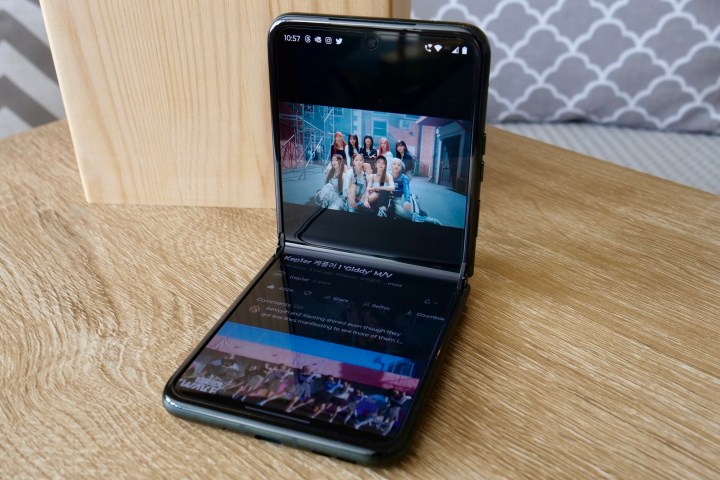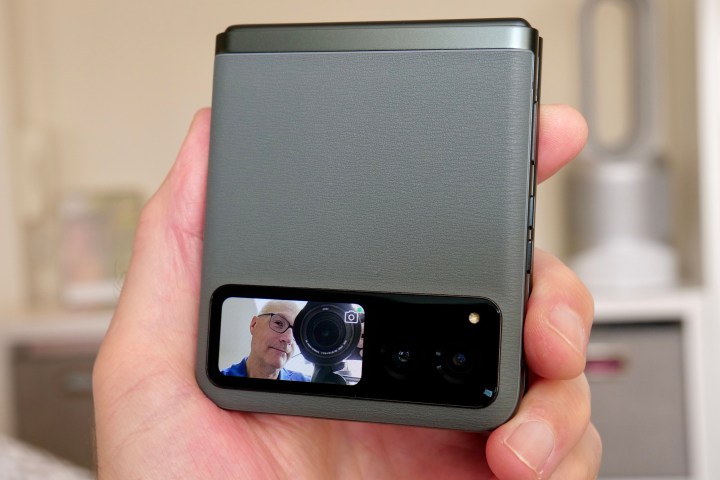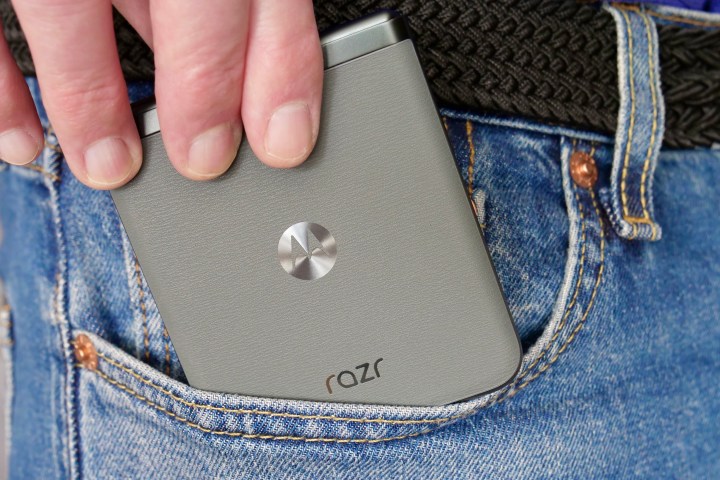
Last year, Motorola jumped back into the flip phone game in a really big way with a duo of Razr models that adopted a more modern and classy design with several fun touches. The 2023 Razr Plus was one of our favorite phones of the year, and now Motorola is back with a pair of sequels that could make an even bigger splash.
While the premium model has gained some powerful new specs, the Razr 2024 is the more interesting of the pair, as Motorola has given it a complete makeover that seriously narrows the gap between the two models. There’s a gorgeous new cover screen on the standard Razr, a new hinge design, and a slew of new AI features. Is that enough to make it a compelling upgrade for owners of last year’s Razr 2023? Let’s take a look.
Motorola Razr 2024 vs. Razr 2023: specs
| Razr 2024 | Razr 2023 | |
|---|---|---|
| Size |
Open: 73.99 x 171.30 x 7.25mm |
Open: 73.95 x 170.82 x 7.35mm Closed: 73.95 x 88.24 x 15.8mm |
| Weight | 188 grams | 188.6 grams |
| Screen |
Main: 6.9-inch pOLED LTPO display with 120Hz refresh rate and 3,000-nit brightness Cover: 3.6-inch pOLED LTPS display with 90Hz refresh rate and 1,700-nit brightness |
Main: 6.9-inch pOLED LTPO display with 120Hz refresh rate and 1,400-nit brightness
Cover: 1.5-inch OLED display with 60Hz refresh rate and 1,000-nit brightness |
| Screen resolution | Main: 2640 x 1080 pixels at 413 pixels-per-inch
Cover: 1056 x 1066 pixels at 413 pixels-per-inch |
Main: 2460 x 1080 pixels at 413 pixels-per-inch
Cover: 194 x 368 pixels at 282 pixels-per-inch |
| Operating system | Android 14 | Android 13 |
| Storage | 256GB | 128GB |
| MicroSD card slot | No | No |
| Processor |
MediaTek Dimensity 7300X |
Snapdragon 7 Gen 1 Mobile Platform |
| Camera | Rear: 50-megapixel (MP) f/1.7 main (wide), 13MP f/2.2 ultrawide/macro
Front: 32MP f/2.4 |
Rear: 64-megapixel (MP) f/1.7 main, 13MP f/2.2 ultrawide/macro
Front: 32MP |
| Video | 4K at 30 frames per second (fps)
1080p HD at 30/60fps |
4K at 30 frames per second (fps)
1080p HD at 30/60fps |
| Cellular | 5G (sub-6GHz), dual eSIM + physical SIM | 5G (sub-6GHz), dual eSIM + physical SIM |
| Bluetooth version | Bluetooth 5.4 | Bluetooth 5.3 |
| Ports | USB-C | USB-C |
| Water resistance | IPX8 | IP52 |
| Battery | 4,200mAh 30W TurboPower charging 15W wireless charging |
4,200mAh 30W TurboPower charging 5W wireless charging |
| Colors | Koala Grey, Beach Sand, Spritz Orange | Sage Green, Vanilla Cream, Summer Lilac, Cherry Blossom |
| Price | $700 | $700 |
Motorola Razr 2024 vs. Razr 2023: design

Last year’s Motorola Razr 2023 was a standout among flip phones for its fun and classy design, and the Razr 2024 is no exception. If anything, it takes that up a notch.
You’ll get the same unique vegan leather finish on the back, which still feels great, but this year, it’s available in an assortment of even more whimsical colors: Koala Grey, Beach Sand, and Spritz Orange.
At a glance, the Razr 2024 is nearly identical to its predecessor in every way but one: This year’s model gets a larger and much more useful cover screen, which we’ll talk about more in the next section. From the “back,” however, you’ll be hard-pressed to tell the two models apart unless you’re familiar with their unique color palettes.

However, that similarity hides another important difference: Motorola has upped its hinge game this year with an entirely new design that’s both smaller and smoother. The Razr 2024 is easier to flip open, and the crease on the inner screen is even more subtle than last year’s Razr 2023, which already did a better job hiding it than most other flip phones.
Both models still feature Gorilla Glass Victus on their cover displays, although the Razr 2024 gets a nice water resistance upgrade, now boasting an IPX8 rating. That’s a significant jump from the IP52 of the Razr 2023. Technically, the loss of the 5 here means this year’s model may be less resistant to dust and sand, but it’s hard to say as the “X” doesn’t mean it’s not dust-resistant — merely that Motorola hasn’t tested it. Still, foldables have never been great in that area anyway. We think it’s fair to say that water resistance is much more important for most folks, and IP52 to IPX8 is a massive improvement.
Motorola Razr 2024 vs. Razr 2023: display

One compelling reason to opt for Motorola’s pricier Razr Plus model last year was its more expansive cover screen. However, that higher price tag was too rich for some people’s blood, and many settled for the 2023 Razr’s smaller 1.5-inch panel.
The good news is you won’t have to make that choice this year, as the standard Razr 2024 has made the leap to a 3.6-inch screen on the outside with a 90Hz refresh rate — more or less the same screen found on the 2023 Razr Plus. Motorola’s newer premium model has a cover screen that goes up a slight notch from that, but the two are far closer than they were last year, to the point where we don’t think anyone is settling by opting for the Razr 2024.

The new cover screen isn’t just bigger, it’s also much more useful. While last year’s Razr was essentially a glorified smartwatch display, the 2024 Razr now has an always-on display that can show full-sized widgets, run any app, and even let you tap out replies to messages using the on-screen keyboard. That means you’ll be flipping this one open much less often.
However, when you do open it up, you’ll be greeted by a 6.9-inch main display that’s virtually the same on both models, although the Razr 2024 is more brilliant, now reaching 3,000 nits of peak brightness. As with last year’s models, this is nearly identical to what Motorola uses on the more expensive Razr Plus, with the only real difference being the refresh rate: 120Hz versus 165Hz.
Motorola Razr 2024 vs. Razr 2023: performance and battery

Motorola swapped chip families this year, powering the 2024 Razr with a MediaTek Dimensity 7300X chip instead of the Snapdragon 7 Gen 1 found in last year’s model. Both are 4nm chips with eight CPU cores that run up to 2.5GHz, so this should translate to at least similar performance. However, MediaTek’s chip is hot off the fabrication line, so we’ll have to wait and see how it holds up under real-world conditions. We’ll have more once we’ve put it through its paces in our review.
The Razr 2024 gets a nice boost in storage capacity to 256GB — twice as much as last year. That’s important, considering Motorola only sells the Razr in a single storage configuration. Both models still have only 8GB of RAM.

Both models will likely be evenly matched in battery life since they pack in the same 4,200mAh cell, although the Razr 2024 may benefit from power efficiency improvements in MediaTek’s new chip. We’ll have to wait and see on that front, but the new cover screen could also make a difference since you won’t need to flip the Razr 2024 open and use the more power-hungry main display nearly as often.
Wired charging remains at 30W. The Razr 2024 gets a boost to more standard 15W wireless charging speeds, compared to 5W on the Razr 2023.
Motorola Razr 2024 vs. Razr 2023: cameras

Cameras have never been the main reason to opt for any Motorola phone, but those in the Razr lineup do noticeably better than much of the rest of the pack. In our testing, the 2023 Razr typically captured colorful and balanced photos that were more than suitable for casual use and sharing online. The biggest downside we found was that the results could be somewhat inconsistent, with some photos feeling a little soft and washed out.
The jury is out on whether the Razr 2024 will improve on that since much of the power comes from the image signal processor, and the MediaTek Dimensity 7300X in this year’s model is a whole new ballgame. In the limited hands-on time we had with the new Razr, the cameras show some promising results, but we’ll have to wait for proper comparisons before we can be sure.
It’s worth mentioning that the main camera has dropped to a 50-megapixel (MP) sensor this year, compared to 64MP on the Razr 2023. We’re assuming that Motorola is making up for that with improved processing, but you’re typically shooting pixel-binned 12.5MP and 16MP photos with these phones anyway, so the difference is pretty subtle. The 13MP ultrawide/macro and 32MP selfie cameras have the same specs on both models.
Motorola Razr 2024 vs. Razr 2023: software and special features

The Razr 2024 will ship with Android 14 out of the box, and thankfully, it seems Motorola is sticking with a frustration-free approach for its higher-end phones: adding minimal cruft to the stock Android experience instead of the bloatware nightmare it brought to the Moto G series earlier this year.
The most significant change is a new “Moto AI” layer that represents the company’s first foray into AI. It’s not so much an Android skin as a collection of tools to improve photography. Most of these are limited to the more premium Razr Plus, although the standard Razr will get AI Auto Smile Capture, a Style Sync feature that can create AI-generated wallpapers from any photo, and a Magic Canvas AI image-generation app.

Google Gemini is also integrated into the 2024 Razr right out of the box and can be called up directly from the cover screen by pressing and holding the power button. Motorola is offering three months of Gemini Advanced for new buyers. The cover screen also features an optimized Google Photos app and special panels for Spotify and Bose.
A few other AI features will come to the Razr 2024 down the road, such as summaries of notifications and text conversations. However, unlike Samsung, Motorola has no plans to bring Moto AI to its older phones, so you’ll need a 2024 Razr if you want to take advantage of these features.
Meanwhile, the Razr 2023 shipped with Android 13 last year, and most owners have yet to see an Android 14 update. That’s par for the course for Motorola, which has always been very slow with its updates; if you really want Android 14, you may be better off just buying this year’s model. Still, Motorola promises three years of Android updates for both, even if they take an excessively long time to arrive. The Razr 2023 will eventually make it to Android 16, while this year’s model should reach 2026’s Android 17 release, although it might not show up for Motorola owners until 2027.
Motorola Razr 2024 vs. Razr 2023: price and availability

The Motorola Razr 2024 has the same $700 MSRP as last year’s Razr 2023, although you’re getting twice the storage for that price, as it now comes in a single 256GB configuration. If the company continues past trends, we’ll likely see some nice discounts in the weeks following its launch. Preorders for the Razr 2024 start on July 10, and it should be available in carrier stores and elsewhere on July 24. It’s available in Koala Grey, Beach Sand, and Spritz Orange.
Meanwhile, the 128GB Motorola Razr 2023 can be had right now for $450 from Motorola’s website, Amazon, Best Buy, and likely a few other retailers. While that’s technically a sale price, we don’t imagine it will go back up after the Razr 2024 hits the streets. Color options here are Sage Green, Vanilla Cream, Summer Lilac, and Cherry Blossom.
Motorola Razr 2024 vs. Razr 2023: should you upgrade?

There’s little doubt that Motorola has made some very nice year-over-year improvements in its 2024 Razr. The significantly better cover screen alone is enough to justify the upgrade for anyone who found last year’s too limiting, and it certainly makes it a much easier choice to save some money by opting for the standard Razr rather than the pricer Razr Plus.
That’s a big improvement, but the other changes in this year’s Razr are smaller quality-of-life enhancements. The new hinge is sleeker, and the Moto AI features are interesting, if a little sparse right now. These add up to things that definitely make the new model the better choice for most folks buying their first flip phone, but aren’t enough to justify an upgrade from the 2023 Razr.
After all, many other things here will likely turn out to be incremental changes at best. The camera system, performance, and battery life may be slightly better, but from the specs, we’re not expecting any significant differences in any of those areas. You’re also still getting only three years of software updates, and they’ll likely arrive at the usual glacial pace.
That doesn’t mean the Razr 2024 isn’t a solid phone. It’s still the best in its class, and if you’re looking for a flip phone on a budget, it’s even harder to go wrong with this year’s Razr. However, it’s a tougher call if you’re still happily toting last year’s model unless you really want that better cover screen.
